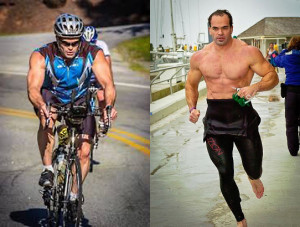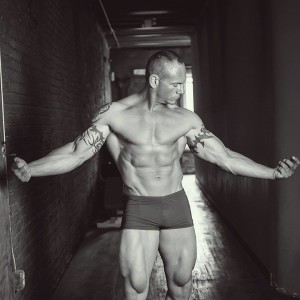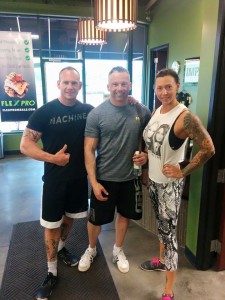How do you exercise or “train” to lose bodyfat?
Well, you’ve got options, Tiger. But first let’s back up a bit.
In my first blog in this fat loss mini-series I covered “why” you should get lean. Specifically, how understanding and embracing “why” makes the whole fat loss process much easier. It’s an often-overlooked step, so if you haven’t read it please start there.
Then I covered how to eat to lose fat, and introduced what I call the 7 Big Rocks of fat loss nutrition.
These aren’t the only things that you can do diet-wise, just the big things that you have to do. Everything else is like the spinning rims on your Escalade.
Still, even experienced, “knowledgeable” folks think there’s a hell of a lot more to it. As such, they make fat loss way more complicated than it needs to be.
Like me for example. For years I was neck-deep in the “confusing knowledge for wisdom” sinkhole. I worried about stuff that while “legitimate” was also trivial in the grand scheme of things.
Do you really need to concern yourself with the nuances of carb loading versus fat loading or the timing of your “peri-workout nutrition” when you don’t know how to track effectively? Or subconsciously cheat on your diet at 11pm?
It wasn’t until I worked with a lot of normal people (and read basically everything Alan Aragon has ever written) that I saw the light.
That a lot of stuff can matter when it comes to fat loss nutrition. But only a few things absolutely, totally matter.
When you’re trying to build muscle or strength, training is super important.
More important than diet even. Just eat even a moderate calorie surplus and make sure there’s enough protein in the mix and you’re on your way. After that, the quality and execution of the program drives the muscle building bus.
However, training for fat loss is different.
Cause as long as you’re in a calorie deficit and doing some sort of resistance training, almost anything can work. Sorta. At least for a while.
Yes, everything – machines, free weights, low reps, high reps, lots of cardio, no cardio, circuits, sports specific training, strongman training, martial arts, even dwarf tossing.
It all can work for fat loss, especially for beginners. Which is why arguing about what’s the best when you’re just starting out is a frivolous endeavour. Not that anyone ever got kicked off the internet for engaging in a frivolous argument, but the point still stands.
Still, while everything can work, if your goal is looking like you lift weights you must be more discerning.
Here are some popular weight training ideologies for fat loss, along with why they’re supposedly “the best.”
High Volume/Reps. The darling of the 80’s bodybuilding scene. Need to lose fat? Better drop the weights and crank up the reps cause, well, high reps really “cut up the muscle.”
We know now that this doesn’t really work. At least not for the reason given.
Bodybuilders certainly got leaner training this way, but they also restricted calories simultaneously. Some also performed considerable amounts of cardio.
So did all those extra reps offer any benefit at all? Not by cutting up the muscle, no, but higher rep training does build muscle and burn calories, and is certainly safer than much heavier loading.
Low Volume, High Intensity (Effort). The theory is you only have so much capacity to recuperate from exercise while dieting, so just cut the volume to bare minimum and go balls deep with one single work set. Hey, it worked for some guy named Dorian.
Still, it isn’t for everyone. You only get one work set to make magic happen, so it forces you to be a “slave” to your log book and beat last workout’s performance.
Which isn’t always practical when you’re tired, or on low carbs, or in a busy gym, or stuck training in a hotel “fitness center” where your options are a stationary bike and a Bowflex.
Furthermore, since training volume is so low, it also requires creating a greater calorie deficit in other areas, be it through diet or cardio. Not to mention, the risk of injury is undeniable. Just ask some guy named Dorian.
Low Volume. Since you can’t build muscle in a calorie deficit, why not just try to “maintain” current size and strength levels and let the diet and cardio “do the work.”
It makes sense I guess. However, it also overestimates the amount of muscle wasting that can occur when weight training in a deficit — excessive cardio causes more — and underestimates what can be accomplished, in terms of muscle growth, even in a mild calorie deficit.
Fact is, many bodybuilders will actually improve weak points (slightly) during a moderate contest prep by working them that much more.
And like the previous method, low volume work requires more attention on the diet or cardio side of the ledger. Or both. Are we having fun yet?
Just Get Strong Bro. Theory is, when dieting you’ll lose kilos of muscle if you don’t stick to “training the way that put the muscle on.” That means going heavy bro.
There’s some logic at work here but it’s also incomplete. Yes, heavy, low rep training builds size and strength. Know what else builds size? High volume training.
When you’re tired, depleted, and running on 4 hours of shoddy sleep, do you really want to go after a big PR? Or suffer through another “10 sets of 2” workout?
On the other hand, a good pump session can have almost a supercharging effect, at least once you get going, while burning considerably more calories than slow sets of 2 or 3 reps.
Circuit Training. Well thought out circuit training is a fantastic fat loss tool. The key is “well thought out,” which isn’t synonymous with “do a bunch of machine exercises for one minute each and then flip a tire for 20 yards.”
On the other hand, alternating big upper & lower lifts or performing “complexes” (overhead presses to squats to dips to deadlifts for example) has been around for decades and can gas even the most conditioned lifter.
There are some goofy theories why circuit training works – it raises GH! – but in the end it just burns a shit ton of calories while creating a serious cardiovascular demand.
But it’s not a great standalone system. Lifters often use loads that are too light, or don’t rest enough between circuits, both of which limits muscle building potential.
Or they allow fatigue to disrupt form to the point of injury. And getting hurt while lifting weights should never be acceptable. Though your Crossfit war stories do make for a great ice breaker.
For that reason, I like to use circuit training sparingly – either:
- In short, 4-week blocks
- Doing 1-3 days a week of circuits plus 1-3 days of more traditional programming
- Doing 1-2 circuits per workout, after more traditional programming.
Lots of Cardio. This idea blows. There’s nothing “bad” about cardio – it’s actually a crucial part of a solid fitness plan – but as a standalone fat loss modality, it’s not that effective, at least when also trying to preserve or obviously increase lean mass.
In my experience, lifters don’t do nearly enough cardio in the “off season” and then try to “cram” a bunch of interval sessions and bouts of steady state into the standard 12 week suicide, I mean, contest prep.
As such, they lose considerable size and end up soft and skinny fat, looking less like lifters and more like they just emerged from digging a tunnel out of Pyongyang.
It’s more effective for most normal folks to use the off-season (when you’re reasonably well fed) to work on conditioning and improve V02 max – in other words, get in better shape. Like an athlete.
Then, when it’s time to lose fat aggressively, adjust the diet while switching to less stressful steady state sessions. And only do what’s required to keep fat loss happening.
Granted, there are many ways to skin this cat. Some can get lean doing high rep circuits and HIT on low calories. But many also get exhausted and see their weight training numbers plummet.
Someone who knows a lot about the subject is Alex Viada of Complete Human Performance. I can’t recommend his book, The Hybrid Athlete, enough.

The best approach for lifting weights to lose fat?
Focusing on building muscle.
Here are some bullet points for how to do it:
• Clean up the diet first. Before you do anything. Refer to my last post for help.
• Ideally, start a “diet phase” after a higher intensity “strength phase,” particularly if you plan on using a higher volume approach.
• To mitigate overtraining, favor shorter workouts, but more of them. I might start off a diet at four-75 minute sessions per week and end at six-40 minute sessions.
• Use “full body” workouts. I put full body in quotations, as I’m not suggesting squatting and benching every day. (Though you could). The more muscle mass you recruit in a workout, the more impactful the session. The trick is to change the emphasis to allow for recovery.
For example, you could end an upper body workout with 15 minutes of sled pushing to hit the lower body without causing much muscle damage, as there’s no eccentric component.
Similarly, you could end a lower body day with Farmer’s walks, or even a few sets of upper body complexes.
• Emphasize big lifts like squats, deadlifts, bench presses, and overhead presses. However, isolation work still has its place. Cause it works.
• Keep reps above 8. Even in the big lifts. It’s not a sin to step away from strength training. And never “grind out” heavy reps when dieting. The risks far outweigh any potential rewards. A high rep “burn,” however, certainly has its place. Sets above 20 works too, ya know.
• Use the rest interval as the progression mechanism. Rather than focusing on adding weight or doing more reps to coax progress, strive to do the same amount of work in less time. Or more work in a fixed amount of time.
One of my favorites, as the lifter gets in better shape, is to gradually reduce the rest between sets, from 75 seconds to 60 to 45 and then to 30 seconds or less.
• To add to the previous point, structure workouts so that you pair antagonists as supersets. So a chest exercise supersetted with a back exercise, quads with hamstrings, biceps with triceps, etc. It’s not a must but is more time efficient than performing straight sets.
• Use near perfect form. You don’t need to time sets with a metronome, but using a slower eccentric (lowering) phase is a safer way to train and cranks up the mental engagement side of the ledger. Try performing high rep squats or leg presses with slower eccentrics and “constant tension, no lockout.” But also train fast sometimes. It works too.
• Think quality volume, not just more volume. Work different parts of the strength curve. Barbell curls followed by standing DB curls followed by cable curls is a waste of time. Though I admire your broness.
• Do more for your weak points. Don’t abandon them just because you’re “dieting.” Granted, you’ll be able to make greater improvements in a calorie surplus, but you can still make progress.
Some new bro-science floating around is that your weak bodyparts are the “first to go” when dieting, so it behooves you to train them more on reduced calories. I’m not sure I buy that one, though I do know you can still make noticeable gains in size and shape when eating lower calories. It’s all in the programming.
• Remember why you’re training — to lose fat and get jacked and make the ladies’ hearts aflutter. Don’t piss and moan that your bench went down 5 pounds and resume “bulking.”
• Do enough cardio to keep fat loss humming.
• Get creative. A weight training program doesn’t have to be a sterile list of sets and reps and exercises. Sometimes you need to toss in a curve ball. Like below.

During my last diet, I wanted to focus on maintaining over even improving my arms.
So that meant hypertrophy work — more volume for biceps and triceps, more pump work, even (gasp!) arm days. You know, the stuff that builds muscle.
But I still wanted to derive a metabolic impact from my training, something endless sets of cable curls wouldn’t provide.
A chance arm workout in Kansas City with my friend and fellow coach Ethan Benda gave me just what I needed.
Ethan calls this workout the “ladder” but it needs a cooler name – like the kidney shitter. Which is how I felt after we were done.
We took eight standard arm exercises (four for biceps, four for triceps) and numbered them 1 to 8.
1. DB Curls
2. Rope Triceps Pressdowns
3. Preacher Curls
4. Overhead Triceps Extension
5. Incline Curls
6. Machine Dips
7. Barbell Curls
8. Close Grip Push-Ups
Then we trained each exercise for 6-10 reps, with no resting between exercises. The trick is how the exercises we’re grouped together.
1
1-2
1-2-3
1-2-3-4
1-2-3-4-5
1-2-3-4-5-6
1-2-3-4-5-6-7
1-2-3-4-5-6-7-8
Rest 3 minutes, then start dropping exercises.
2-3-4-5-6-7-8
3-4-5-6-7-8
4-5-6-7-8
5-6-7-8
6-7-8
7-8
8
Hence the name “ladder.”
The entire session took 40 minutes and God knows how many reps we did. I just know by the halfway point I was gassed and the veins were popping out of my arms (and my forehead).
To round it out I suppose I should’ve done some sled pushes or treadmill sprints but what I really needed was a plate of BBQ, three beers, and a nap.
I wouldn’t train like this every day or even every arm day. But it shows that you can still use hypertrophy protocols even in a fat loss context.
There’s nothing magic about training for fat loss. It’s far more important that you hit the dietary “big rocks” than stress about perfect loading parameters.
But to sum it up succinctly:
• Focus on training to build muscle.
• Do a sufficient volume of work.
• Keep rest intervals shorter.
• Feel the intended muscle work — get a pump.
• Do enough cardio.
• Bust your ass.
But above all, enjoy the process. This is supposed to be fun, right?
Next post, I’ll round this series out with what I know best – broscience. And how some things I’ve learnt along the way can make your fat loss efforts a lot more effective.
No Bullshit
Some guys just want to look good. Others are willing to learn what it takes. Which guy are you? Click here to learn more about building the body you want.


